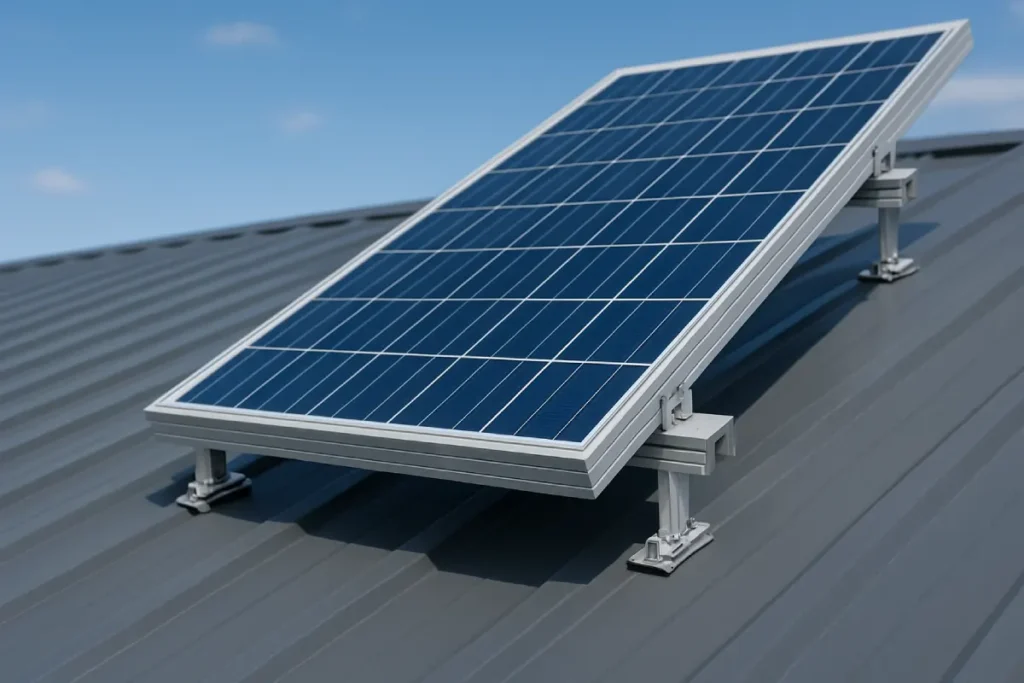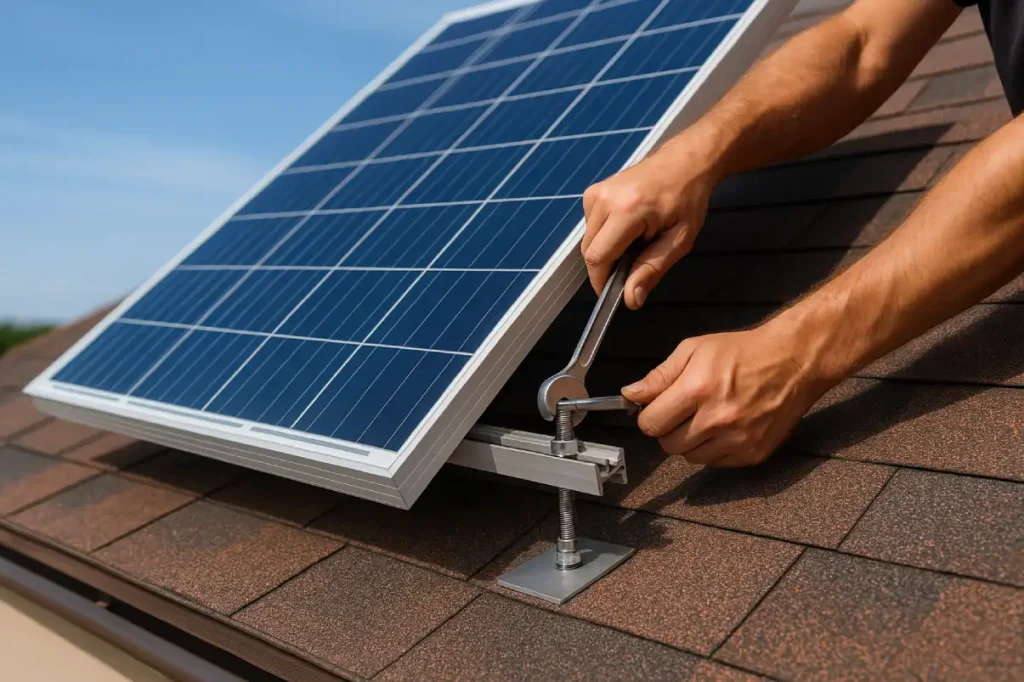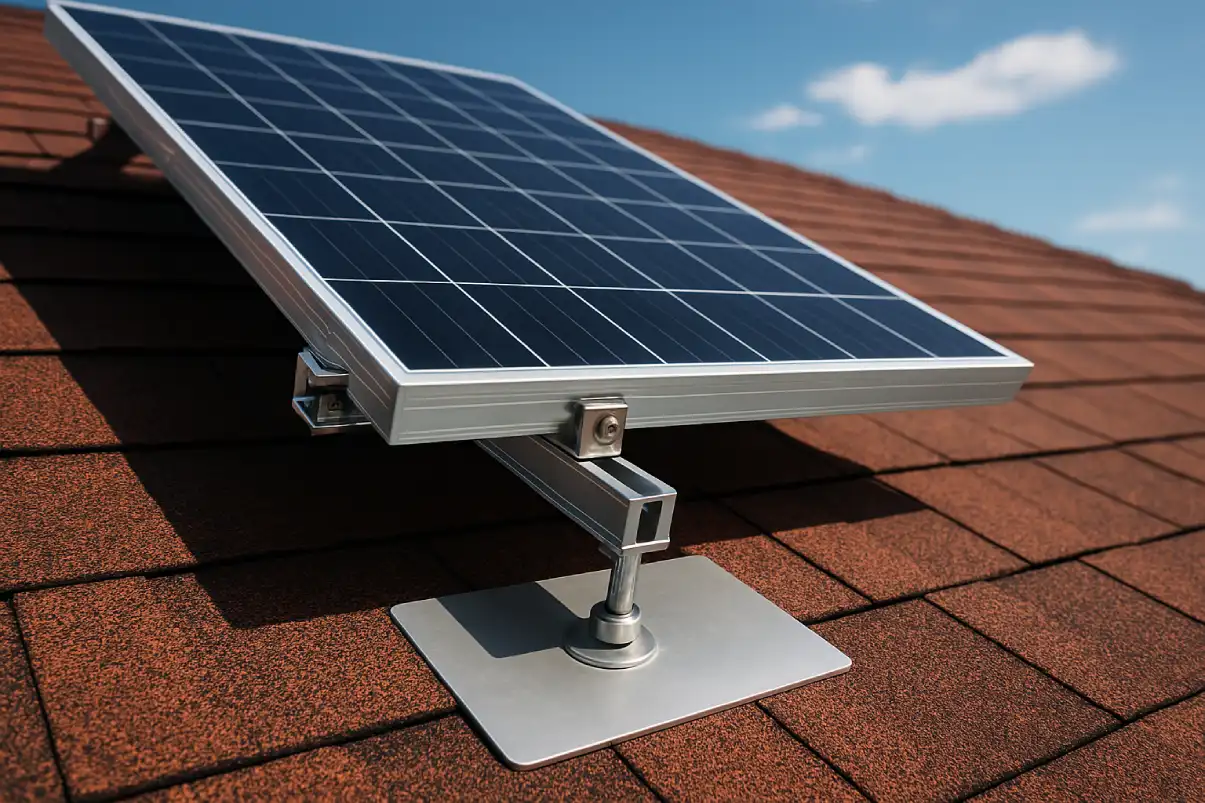Solar panel roof mounts play a crucial role in the installation of solar energy systems. These mounts ensure that solar panels are securely attached to the roof, allowing them to capture sunlight efficiently. Choosing the right mounting system is as important as selecting the solar panels themselves. Proper installation not only maximizes energy production but also enhances the longevity of the roof and solar equipment.
In this guide, we’ll explore the various types and installation techniques of solar panel roof mounts. Understanding the differences in mounting systems helps in making an informed decision tailored to specific roof types and energy needs. Whether you have a shingle or metal roof, knowing which mounts suit your home best could significantly impact your solar panel’s performance and durability.
What Are Solar Panel Roof Mounts?
Solar panel roof mounts are specialized hardware systems used to attach solar panels to the roof securely. These mounts serve as the structural support for panels, ensuring they remain in place under various weather conditions and optimizing solar angle for maximum sun exposure. Roof mounts come in various styles and designs, each tailored to different roof types and installation preferences.
Roof mounts can be categorized into flush mounts and tilted mounts. Flush mounts are flat against the roof surface, perfect for homes with good solar orientation. Tilted mounts, on the other hand, are adjustable, allowing panels to be angled to capture maximum sunlight. This flexibility can lead to better energy efficiency, especially in areas where roof orientation is less than optimal.
Understanding the essential hardware for solar installations is vital, as it includes selecting the correct type of mounts. Properly chosen and installed mounts contribute significantly to the overall effectiveness of a solar power system. They ensure that the panels stay secure, aligned correctly, and perform optimally over their lifespan.
Benefits of Using Proper Solar Panel Mounts
Using the right solar panel mounts ensures several benefits. First, they provide structural support, which is crucial for the safety and longevity of both the solar panels and the roof. Proper mounts prevent panels from being dislodged by strong winds or heavy snowfall, thus protecting your investment.
Another benefit is efficiency. By choosing mounts that allow for tilt optimization, homeowners can maximize solar energy absorption. Adjustable mounts accommodate seasonal sun angle changes, enhancing system performance year-round. This flexibility can lead to higher efficiency and better return on investment over time.
Moreover, installing proper mounts reduces the risk of roof damage. Incorrect installation might lead to leaks or structural issues. Ensuring compatibility with your roof type, whether it’s a shingle or metal roof, helps preserve the roof’s integrity. Choosing the right mounts aids in compliance with building codes and permits, which are essential for legal and safe installation.
Types of Solar Panel Roof Mounts Explained
There are several types of solar panel roof mounts, each designed for specific roof types and installation scenarios. Understanding these differences helps in selecting the most suitable option for your home.
Flush mounts are one of the most common and are often used on roofs with a favorable inclination. They attach solar panels directly to the roof, providing a streamlined, low-profile appearance. This type of mounting is ideal for areas with little to no snow accumulation and where roof angle and orientation naturally align well with sunlight.
Tilted mounts, conversely, offer angle adjustment. These mounts are ideal for flat roofs or where the existing roof angle doesn’t provide optimal solar exposure. By adjusting the panel angle, they maximize sunlight capture, which can be particularly advantageous in regions with low sun angles in winter months.
Ballasted mounts and penetrating mounts are two other options. Ballasted mounts are often used in commercial flat-roof installations, relying on weight instead of roof penetration to secure the panels. Penetrating mounts, however, involve securing the panels directly to the roof structure, offering more stability in windy conditions.
Fixed Mounts vs Adjustable Mounts
The choice between fixed and adjustable mounts depends largely on the roof type and the desired flexibility. Fixed mounts are less expensive and simpler to install, as they don’t offer angle adjustment. They’re suited for roofs that already have an optimal angle towards the sun.
Adjustable mounts, however, provide the flexibility to change the angle of the panels. This adjustment can maximize energy production during different times of the year. Although more expensive, adjustable mounts can lead to better long-term energy yields, especially on flat roofs or in regions with varied seasonal sun paths.
Ballasted Mounts vs Penetrating Mounts
Ballasted mounts offer a non-intrusive installation solution, primarily for flat roofs. They hold panels in place using weights, eliminating the need for roof penetrations. This type is particularly popular in commercial settings where roof integrity is a concern.
On the contrary, penetrating mounts provide a more permanent solution. They involve anchoring the panels directly to the roof structure, which can offer greater wind resistance. While this method requires careful sealing to prevent leaks, it ensures a solid and durable installation, ideal for areas prone to high winds.
Choosing Solar Panel Mounts for Shingle Roofs
When selecting solar panel mounts for a shingle roof, it’s important to consider the roof’s material and structure. Shingle roofs are common, and many mounting systems are designed to cater to their specific needs. The key is to ensure that the mounts provide a secure attachment without damaging the shingles.
A flush mounting system is often ideal for shingle roofs, as it integrates well with the roof’s surface. It minimizes wind resistance and blends aesthetically with the roofline. The solar panel installation process should involve detailed roofing installation steps to avoid shingle damage and potential leaks.
It’s also crucial to consider the roof’s orientation and pitch. Employing mounts that offer some degree of adjustability can help maximize solar capture, especially if the roof’s angle is not perfectly aligned with the sun’s path. Properly installed mounts will protect the roof and ensure the solar panel system’s longevity.
Best Solar Panel Mounts for Shingle Roof Installations
For shingle roof installations, choosing the right mounts involves balancing aesthetics, durability, and performance. Low-profile mounts are often preferred, as they provide a sleek appearance and reduce the impact of wind loads on the panels.
Products like rail-mounted systems and flashings are popular for their ease of installation and reliability. These mounts use a rail system to securely attach panels, distributing weight evenly across the roof structure. Flashings protect against water intrusion, a crucial aspect of maintaining roof integrity.
Another effective solution is using clamp-based systems that secure panels without penetrating the shingles extensively. This minimizes the risk of leaks while offering strong anchoring. Careful selection of mounts tailored to shingle roofs ensures efficient energy production and long-term system resilience.
Installation Tips for Shingle Roof Mounting Systems
Proper installation of mounting systems on shingle roofs requires careful planning and execution. First, assess the roof’s condition and ensure it’s in good shape to support the solar panels and mounting hardware. Any repairs should be made before installation begins.
Use flashing kits designed for shingle roofs to prevent leaks. These kits help seal penetrations in the roof, adding an extra layer of protection against water damage. It’s essential to follow the manufacturer’s instructions closely to ensure a watertight seal.
During installation, ensure that all hardware, including clamps and rails, is securely fastened. This prevents movement and potential damage to the shingles. Regular inspection of the installation is recommended to ensure all components remain secure and effective over time.

Choosing Solar Panel Mounts for Metal Roofs
When selecting mounts for metal roofs, compatibility with the roof’s design is essential. Metal roofs are durable and offer excellent support for solar installations, but they require specialized mounting systems to accommodate their unique structures, such as standing seams or corrugated patterns.
Rail-based systems are a popular choice for metal roofs, providing strong support and easy installation. These systems are designed to work with metal roof profiles, ensuring a secure fit without compromising the roof’s integrity. The choice of solar panel mounts for metal roof installations should take into account the roof’s type and material, ensuring that the mounting solution complements the existing structure.
Another consideration is how the mounts will be installed. Non-penetrating mounts, such as clamp systems, are favored for metal roofs to prevent potential leaks. These mounts attach directly to the roof seams, offering a secure installation without the need for drilling into the roof.
Solar Panel Metal Roof Mounts: Clamps, Rails & Flashings
For metal roofs, using clamps, rails, and flashings is an effective way to secure solar panels. Clamps designed for standing seam metal roofs attach directly to the seams, providing a strong hold without roof penetration. This method maintains the roof’s integrity and water-tightness.
Rail systems are often used in conjunction with clamps, offering a stable platform for panel installation. The rails distribute the weight of the panels evenly across the roof, reducing stress on individual seams. Flashings can be added to further protect against water intrusion, particularly in areas where the roof structure is penetrated.
These mounting options provide a versatile and durable solution for metal roofs. By selecting the appropriate combination of clamps, rails, and flashings, homeowners can ensure a secure and efficient solar panel installation.
Compatibility with Standing Seam and Corrugated Roofs
Solar panel mounts for metal roofs must also be compatible with the specific roof profile, such as standing seam or corrugated metal. Standing seam roofs allow for the simplest installation using seam clamps, which attach directly to the seam and provide a non-invasive solution.
Corrugated metal roofs require different considerations. Specially designed mounts can adapt to the corrugated pattern, ensuring a secure fit. These mounts often involve more complex attachment systems that account for the unique shape of the roof.
Both roof types offer excellent support for solar installations, but choosing the right mounting system is crucial. Ensuring compatibility with the specific metal roof design helps maintain the roof’s structural integrity while maximizing the solar panel system’s effectiveness.
Pros and Cons of Metal Roof Solar Panel Mounts
Metal roof solar panel mounts offer several advantages and some drawbacks. One of the main benefits is durability. Metal roofs are strong and can support solar panels effectively, reducing the risk of damage to the roof itself. The use of non-penetrating mounts further preserves the roof’s integrity.
Another advantage is ease of installation. Systems like clamp mounts simplify the installation process, as they don’t require drilling into the roof. This not only saves time but also minimizes the risk of leaks, maintaining the roof’s watertight properties.
However, cost can be a disadvantage. Metal roof mounts might be more expensive than those for other roof types. The initial investment is higher, but the long-term durability often justifies the cost. Additionally, finding the right mounts for unique metal roof profiles can be challenging, requiring careful selection and possibly custom solutions.
Tools and Equipment Needed for Installation
Installing solar panel roof mounts requires specific tools and equipment to ensure a safe and effective installation. Basic tools like drills, wrenches, and screwdrivers are essential. For precise work, a torque wrench may be needed to ensure bolts and screws are tightened to the manufacturer’s specifications.
Other necessary equipment includes ladders or scaffolding to access the roof safely. Safety harnesses are crucial for working at heights, protecting installers from falls. A chalk line helps mark the exact placement of mounts and panels, ensuring accurate alignment.
Additionally, specialized tools may be required depending on the roof type. For metal roofs, seam clamps require specific tightening tools to ensure a secure fit. Flashing kits and sealants are also essential, particularly for shingle roofs, to prevent water intrusion post-installation.

Installation Guide for Solar Panel Roof Mounts
The installation of solar panel roof mounts involves several critical steps, each essential to the system’s overall success and longevity. Proper installation ensures the panels are secure, efficient, and compliant with building codes.
Step-by-Step Installation Process
Begin the installation by assessing the roof’s condition and determining the optimal panel placement. This involves considering factors like sun exposure and roof pitch, learn how orientation impacts efficiency. Next, lay out the mounting hardware according to the panel layout, marking where each mount will go with a chalk line.
For shingle roofs, use flashing kits to protect against water leaks. Drill pilot holes where the mounts will be fastened, ensuring they align with structural support points like rafters. Secure the mounts using appropriate fasteners, and double-check alignment to ensure everything is straight and level.
On metal roofs, attach seam clamps to the standing seams without penetrating the roof. Rails are then attached to these clamps, providing a base for the panels. Check all connections for tightness and integrity before proceeding to panel installation.
Common Challenges During Installation
During installation, several challenges may arise. One common issue is roof compatibility. Ensure that the chosen mounts are suitable for the specific roof type and material, as incompatible mounts can lead to installation problems or roof damage.
Weather conditions can also pose challenges. Installations should be scheduled during favorable weather to avoid safety risks and ensure proper sealing of all penetrations. Wind, rain, and extreme temperatures can complicate the process, so planning is crucial.
Finally, regulatory compliance can be a hurdle. Understanding local building codes and securing the necessary permits are essential steps in the installation process. This ensures that the system is legal, safe, and eligible for any available incentives or rebates.
Maintenance Tips for Solar Panel Roof Mounts
Maintaining solar panel roof mounts is crucial for long-term performance and safety. Regular maintenance ensures that the mounts and panels remain secure, efficient, and free from damage.
Inspecting Mounts for Wear and Corrosion
Regular inspections of solar panel mounts help identify signs of wear or corrosion. Check for loose bolts, rust, and any signs of physical damage. Address these issues promptly to prevent further deterioration that could compromise the system’s integrity.
It’s important to inspect mounts after severe weather events, such as storms or heavy snowfall. These conditions can stress the mounts and cause loosening or damage. Early detection allows for timely repairs, preventing more significant issues down the line.
Enhancing Longevity with Proper Care
To enhance the longevity of solar panel mounts, follow a consistent maintenance schedule. Clean the panels and mounts regularly to prevent the buildup of debris, which can cause wear over time. Use appropriate cleaning solutions that won’t damage the metal or other mounting materials.
Apply corrosion inhibitors on metal components to protect against rust, especially in areas with high humidity or salt exposure. Ensure that all fastenings are tight and secure, as loose components can lead to system failures.
By maintaining solar panel mounts diligently, homeowners can ensure the system’s efficiency and prolong the life of both the mounts and the roof.
Costs of Solar Panel Mounting Systems
The cost of solar panel mounting systems varies depending on several factors, including the roof type, mount materials, and installation complexity. Understanding these costs is essential for budgeting and planning a solar installation.
Factors That Influence Pricing
Several factors influence the pricing of solar panel mounting systems. The type of roof plays a significant role, as mounts for metal roofs might be more expensive due to their specialized design. The choice between fixed and adjustable mounts can also impact the cost, with adjustable options generally being pricier.
Material quality is another factor. High-quality, durable materials often come at a higher cost but offer better longevity and performance. The complexity of the installation process, including the need for specialized tools or custom solutions, can add to the overall expense.
Permits and compliance costs also contribute to the total investment. Understanding local regulations and accounting for permit fees is crucial in the planning stages to avoid unexpected costs.
Permits and Compliance for Roof Mount Systems
Ensuring compliance with local building codes and securing the necessary permits is a critical step in the installation process. Permits confirm that the system is safe, legal, and meets all regulatory standards.
Research the specific requirements in your area, as they can vary significantly. This includes electrical permits, structural assessments, and zoning approvals. Engage with a licensed installer familiar with local codes to streamline the permit process and ensure all regulations are met.
By adhering to compliance requirements and securing the necessary permits, homeowners can enjoy peace of mind knowing their solar system is safe and eligible for any potential incentives.
Summary
Choosing the right solar panel roof mounts is pivotal for the success of a solar energy system. Understanding the various types of mounts and their specific applications can lead to better system performance, longevity, and cost-effectiveness. Whether dealing with shingle or metal roofs, selecting mounts that complement the roof’s design and materials ensures a secure and efficient installation. Proper installation and regular maintenance maximize the solar energy system’s benefits, providing clean energy for years to come.
